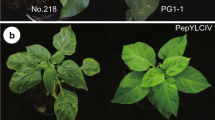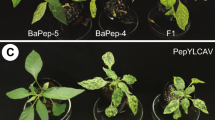Abstract
To evaluate the involvement of translation initiation factors eIF4E and eIFiso4E in Chilli veinai mottle virus (ChiVMV) infection in pepper, we conducted a genetic analysis using a segregating population derived from a cross between Capsicum annuum ‘Dempsey’ containing an eIF4E mutation (pvr1 2) and C. annuum ‘Perennial’ containing an eIFiso4E mutation (pvr6). C. annuum ‘Dempsey’ was susceptible and C. annuum ‘Perennial’ was resistant to ChiVMV. All F1 plants showed resistance, and F2 individuals segregated in a resistant-susceptible ratio of 166:21, indicating that many resistance loci were involved. Seventy-five F2 and 329 F3 plants of 17 families were genotyped with pvr1 2 and pvr6 allele-specific markers, and the genotype data were compared with observed resistance to viral infection. All plants containing homozygous genotypes of both pvr1 2 and pvr6 were resistant to ChiVMV, demonstrating that simultaneous mutations in eIF4E and eIFiso4E confer resistance to ChiVMV in pepper. Genotype analysis of F2 plants revealed that all plants containing homozygous genotypes of both pvr1 2 and pvr6 showed resistance to ChiVMV. In protein-protein interaction experiments, ChiVMV viral genome-linked protein (VPg) interacted with both eIF4E and eIFiso4E. Silencing of eIF4E and eIFiso4E in the VIGS experiment showed reduction in ChiVMV accumulation. These results demonstrated that ChiVMV can use both eIF4E and eIFiso4E for replication, making simultaneous mutations in eIF4E and eIFiso4E necessary to prevent ChiVMV infection in pepper.
Similar content being viewed by others
References
Ahlquist, P., Noueiry, A.O., Lee, W.M., Kushner, D.B., and Dye, B.T. (2003). Host factors in positive-strand RNA virus genome replication. J. Virol. 77, 8181–8186.
Caranta, C., Lefebvre, V., and Palloix, A. (1997). Polygenic resistance of pepper to potyviruses consists of a combination of isolate-specific and broad-spectrum quantitative trait loci. Mol. Plant Microbe Interact. 10, 872–878.
Charron, C., Nicolaï, M., Gallois, J.-L., Robaglia, C., Moury, B., Palloix, A., and Caranta, C. (2008). Natural variation and functional analyses provide evidence for co-evolution between plant eIF4E and potyviral VPg. Plant J. 54, 56–68.
Chisholm, S.T., Coaker, G., Day, B., and Staskawicz, B.J. (2006). Host-microbe interactions: shaping the evolution of the plant immune response. Cell 124, 803–814.
Dangl, J.L. and Jones, J.D. (2001). Plant pathogens and integrated defence responses to infection. Nature 411, 826–833.
Gao, Z., Johansen, E., Eyers, S., Thomas, C.L., Noel Ellis, T.H., and Maule, A.J. (2004). The potyvirus recessive resistance gene, sbm1, identifies a novel role for translation initiation factor eIF4E in cell-to-cell trafficking. Plant J. 40, 376–385.
Green, S.K., Hiskias, Y., Lesemann, D.E., and Vetten, H.J. (1999). Characterization of Chilli veinal mottle virus as a potyvirus distinct from Pepper veinal mottle virus. Petria 9, 332.
Grube, R.C., Radwanski, E.R., and Jahn, M. (2000a). Comparative genetics of disease resistance within the solanaceae. Genetics 155, 873–887.
Grube, R.C., Blauth, J.R., Arnedo-A, M.S., Caranta, C., and Jahn, M. (2000b). Identification and comparative mapping of a dominant potyvirus resistance gene cluster in Capsicum. Theor. Appl. Genet. 101, 852–859.
Grzela, R., Strokovska, L., Andrieu, J.P., Dublet, B., Zagorski, W., and Chroboczek, J. (2006). Potyvirus terminal protein VPg, effector of host eukaryotic initiation factor eIF4E. Biochimie 88, 887–896.
Kang, B.C., Yeam, I., and Jahn, M.M. (2005a). Genetics of plant virus resistance. Annu. Rev. Phytopathol. 43, 581–621.
Kang, B.C., Yeam, I., Frantz, J.D., Murphy, J.F., and Jahn, M.M. (2005b). The pvr1 locus in Capsicum encodes a translation initiation factor eIF4E that interacts with Tobacco etch virus VPg. Plant J. 42, 392–405.
Kang, B.C., Yeam, I., Li, H., Perez, K.W., and Jahn, M.M. (2007). Ectopic expression of a recessive resistance gene generates dominant potyvirus resistance in plants. Plant Biotechnol. J. 5, 526–536.
Kushner, D.B., Lindenbach, B.D., Grdzelishvili, V.Z., Noueiry, A.O., Paul, S.M., and Ahlquist, P. (2003). Systematic, genome-wide identification of host genes affecting replication of a positive-strand RNA virus. Proc. Natl. Acad. Sci. USA 100, 15764–15769.
Kyle, M.M., and Palloix, A. (1997). Proposed revision of nomenclature for potyvirus resistance genes in Capsicum. Euphytica 97, 183–188.
Liu, Y., Schiff, M., and Dinesh-Kumar, S.P. (2002). Virus-induced gene silencing in tomato. Plant J. 31, 777–786.
Michelmore, R.W., and Meyers, B.C. (1998). Clusters of resistance genes in plants evolve by divergent selection and a birth-and-death process. Genome Res. 8, 1113–1130.
Moury, B., Palloix, A., Caranta, C., Gognalons, P., Souche, S., Gebre Selassie, K., and Marchoux, G. (2005). Serological, molecular and pathotype diversity of Pepper veinal mottle virus and Chilli veinal mottle virus. Phytopathology 95, 227–232.
Murphy, J.F., Blauth, J.R., Livingstone, K.D., Lackney, V.K., and Jahn, M. (1998). Genetic mapping of the pvr1 locus in Capsicum spp. and evidence that distinct potyvirus resistance loci control responses that differ at the whole plant and cellular levels. Mol. Plant Microbe Interact. 11, 943–951.
Nieto, C., Piron, F., Dalmais, M., Marco, C.F., Moriones, E., Gomez-Guillamon, M.L., Truniger, V., Gomez, P., Garcia-Mas, J., Aranda, M.A., et al. (2007). EcoTILLING for the identification of allelic variants of melon eIF4E, a factor that controls virus susceptibility. BMC Plant Biol. 7, 34.
Prince, J.P., Zhang, Y., Radwanski, E.R., and Kyle, M.M. (1997). A versatile and high-yielding protocol for the preparation of genomic DNA from Capsicum spp. (pepper). Hort. Sci. 32, 937–939.
Robaglia, C., and Caranta, C. (2006). Translation initiation factors: a weak link in plant RNA virus infection. Trends Plant Sci. 11, 40–45.
Ruffel, S., Gallois, J.L., Moury, B., Robaglia, C., Palloix, A., and Caranta, C. (2006). Simultaneous mutations in translation initiation factors eIF4E and eIF(iso)4E are required to prevent pepper veinal mottle virus infection of pepper. J. Gen. Virol. 87, 2089–2098.
Sato, M., Nakahara, K., Yoshii, M., Ishikawa, M., and Uyeda, I. (2005). Selective involvement of members of the eukaryotic initiation factor 4E family in the infection of Arabidopsis thaliana by potyviruses. FEBS Lett. 579, 1167–1171.
Siriwong, P., Kittipakorn, K., and Ikegami, M. (1995). Characterization of Chilli vein-banding mottle virus isolated from pepper in Thailand. Plant Path. 44, 718–727.
Stein, N., Perovic, D., Kumlehn, J., Pellio, B., Stracke, S., Streng, S., Ordon, F., and Graner, A. (2005). The eukaryotic translation initiation factor 4E confers multiallelic recessive Bymovirus resistance in Hordeum vulgare (L). Plant J. 42, 912–922.
Tsai, W.S., Huang, Y.C., Zhang, D.Y., Reddy, K., Hidayat, S.H., Srithongchai, W., Green, S.K., and Jan, F.-J. (2008). Molecular characterization of the CP gene and 3′UTR of Chilli veinal mottle virus from South and Southeast Asia. Plant Path. 57, 408–416.
Wang, J., Liu, Z., Niu, S., Peng, M., and Wang, D. (2006). Natural occurrence of Chilli veinal mottle virus on Capsicum chinense in China. Plant Disease 90, 377.
Yeam, I., Kang, B.C., Lindeman, W., Frantz, J.D., Faber, N., and Jahn, M.M. (2005). Allele-specific CAPS markers based on point mutations in resistance alleles at the pvr1 locus encoding eIF4E in Capsicum. Theor. Appl. Genet. 112, 178–186.
Yeam, I., Cavatorta, J.R., Ripoll, D.R., Kang, B.C., and Jahn, M.M. (2007). Functional dissection of naturally occurring amino acid substitutions in eIF4E that confers recessive potyvirus resistance in plants. Plant Cell 19, 2913–2928.
Author information
Authors and Affiliations
Corresponding author
Additional information
These authors contributed equally to this work.
About this article
Cite this article
Hwang, J., Li, J., Liu, WY. et al. Double mutations in eIF4E and eIFiso4E confer recessive resistance to Chilli veinal mottle virus in pepper. Mol Cells 27, 329–336 (2009). https://doi.org/10.1007/s10059-009-0042-y
Received:
Revised:
Accepted:
Published:
Issue Date:
DOI: https://doi.org/10.1007/s10059-009-0042-y




